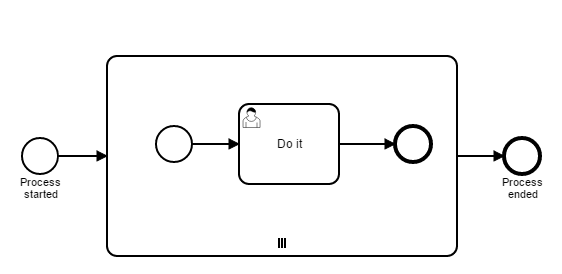Hi all
I use the following process model:

The code can be found here:
The activity “Do it” has a registered execution listener (EventType = end).
When I set a break point inside the execution listener and finish two activities “Do it” at the same time so that the execution listener gets hit by both activities, then the following exception is raised.
What is wrong with the sample code?
05-May-2017 15:34:38.672 WARNING [http-nio-8080-exec-20] null.null org.camunda.bpm.engine.rest.exception.RestException: Cannot submit task form 8bdb57d9-3197-11e7-9555-08606ed85232: ENGINE-03005 Execution of 'UPDATE ExecutionEntity[8bda9466-3197-11e7-9555-08606ed85232]' failed. Entity was updated by another transaction concurrently.
at org.camunda.bpm.engine.rest.sub.task.impl.TaskResourceImpl.submit(TaskResourceImpl.java:126)
at sun.reflect.NativeMethodAccessorImpl.invoke0(Native Method)
at sun.reflect.NativeMethodAccessorImpl.invoke(Unknown Source)
at sun.reflect.DelegatingMethodAccessorImpl.invoke(Unknown Source)
at java.lang.reflect.Method.invoke(Unknown Source)
at org.jboss.resteasy.core.MethodInjectorImpl.invoke(MethodInjectorImpl.java:167)
at org.jboss.resteasy.core.ResourceMethod.invokeOnTarget(ResourceMethod.java:257)
at org.jboss.resteasy.core.ResourceMethod.invoke(ResourceMethod.java:222)
at org.jboss.resteasy.core.ResourceLocator.invokeOnTargetObject(ResourceLocator.java:159)
at org.jboss.resteasy.core.ResourceLocator.invoke(ResourceLocator.java:107)
at org.jboss.resteasy.core.ResourceLocator.invokeOnTargetObject(ResourceLocator.java:154)
at org.jboss.resteasy.core.ResourceLocator.invoke(ResourceLocator.java:92)
at org.jboss.resteasy.core.SynchronousDispatcher.getResponse(SynchronousDispatcher.java:542)
at org.jboss.resteasy.core.SynchronousDispatcher.invoke(SynchronousDispatcher.java:524)
at org.jboss.resteasy.core.SynchronousDispatcher.invoke(SynchronousDispatcher.java:126)
at org.jboss.resteasy.plugins.server.servlet.ServletContainerDispatcher.service(ServletContainerDispatcher.java:208)
at org.jboss.resteasy.plugins.server.servlet.HttpServletDispatcher.service(HttpServletDispatcher.java:55)
at org.jboss.resteasy.plugins.server.servlet.HttpServletDispatcher.service(HttpServletDispatcher.java:50)
at javax.servlet.http.HttpServlet.service(HttpServlet.java:729)
at org.apache.catalina.core.ApplicationFilterChain.internalDoFilter(ApplicationFilterChain.java:291)
at org.apache.catalina.core.ApplicationFilterChain.doFilter(ApplicationFilterChain.java:206)
at org.apache.tomcat.websocket.server.WsFilter.doFilter(WsFilter.java:52)
at org.apache.catalina.core.ApplicationFilterChain.internalDoFilter(ApplicationFilterChain.java:239)
at org.apache.catalina.core.ApplicationFilterChain.doFilter(ApplicationFilterChain.java:206)
at org.camunda.bpm.engine.rest.filter.CacheControlFilter.doFilter(CacheControlFilter.java:41)
at org.apache.catalina.core.ApplicationFilterChain.internalDoFilter(ApplicationFilterChain.java:239)
at org.apache.catalina.core.ApplicationFilterChain.doFilter(ApplicationFilterChain.java:206)
at org.camunda.bpm.webapp.impl.security.filter.SecurityFilter.doFilterSecure(SecurityFilter.java:67)
at org.camunda.bpm.webapp.impl.security.filter.SecurityFilter.doFilter(SecurityFilter.java:51)
at org.apache.catalina.core.ApplicationFilterChain.internalDoFilter(ApplicationFilterChain.java:239)
at org.apache.catalina.core.ApplicationFilterChain.doFilter(ApplicationFilterChain.java:206)
at org.camunda.bpm.webapp.impl.security.auth.AuthenticationFilter$1.execute(AuthenticationFilter.java:59)
at org.camunda.bpm.webapp.impl.security.auth.AuthenticationFilter$1.execute(AuthenticationFilter.java:56)
at org.camunda.bpm.webapp.impl.security.SecurityActions.runWithAuthentications(SecurityActions.java:38)
at org.camunda.bpm.webapp.impl.security.auth.AuthenticationFilter.doFilter(AuthenticationFilter.java:56)
at org.apache.catalina.core.ApplicationFilterChain.internalDoFilter(ApplicationFilterChain.java:239)
at org.apache.catalina.core.ApplicationFilterChain.doFilter(ApplicationFilterChain.java:206)
at org.apache.catalina.core.StandardWrapperValve.invoke(StandardWrapperValve.java:219)
at org.apache.catalina.core.StandardContextValve.invoke(StandardContextValve.java:106)
at org.apache.catalina.authenticator.AuthenticatorBase.invoke(AuthenticatorBase.java:502)
at org.apache.catalina.core.StandardHostValve.invoke(StandardHostValve.java:142)
at org.apache.catalina.valves.ErrorReportValve.invoke(ErrorReportValve.java:79)
at org.apache.catalina.valves.AbstractAccessLogValve.invoke(AbstractAccessLogValve.java:617)
at org.apache.catalina.core.StandardEngineValve.invoke(StandardEngineValve.java:88)
at org.apache.catalina.connector.CoyoteAdapter.service(CoyoteAdapter.java:518)
at org.apache.coyote.http11.AbstractHttp11Processor.process(AbstractHttp11Processor.java:1091)
at org.apache.coyote.AbstractProtocol$AbstractConnectionHandler.process(AbstractProtocol.java:668)
at org.apache.tomcat.util.net.NioEndpoint$SocketProcessor.doRun(NioEndpoint.java:1527)
at org.apache.tomcat.util.net.NioEndpoint$SocketProcessor.run(NioEndpoint.java:1484)
at java.util.concurrent.ThreadPoolExecutor.runWorker(Unknown Source)
at java.util.concurrent.ThreadPoolExecutor$Worker.run(Unknown Source)
at org.apache.tomcat.util.threads.TaskThread$WrappingRunnable.run(TaskThread.java:61)
at java.lang.Thread.run(Unknown Source)
Caused by: org.camunda.bpm.engine.OptimisticLockingException: ENGINE-03005 Execution of 'UPDATE ExecutionEntity[8bda9466-3197-11e7-9555-08606ed85232]' failed. Entity was updated by another transaction concurrently.
at org.camunda.bpm.engine.impl.db.EnginePersistenceLogger.concurrentUpdateDbEntityException(EnginePersistenceLogger.java:125)
at org.camunda.bpm.engine.impl.db.entitymanager.DbEntityManager.handleOptimisticLockingException(DbEntityManager.java:323)
at org.camunda.bpm.engine.impl.db.entitymanager.DbEntityManager.flushDbOperationManager(DbEntityManager.java:295)
at org.camunda.bpm.engine.impl.db.entitymanager.DbEntityManager.flush(DbEntityManager.java:278)
at org.camunda.bpm.engine.impl.interceptor.CommandContext.flushSessions(CommandContext.java:247)
at org.camunda.bpm.engine.impl.interceptor.CommandContext.close(CommandContext.java:176)
at org.camunda.bpm.engine.impl.interceptor.CommandContextInterceptor.execute(CommandContextInterceptor.java:113)
at org.camunda.bpm.engine.impl.interceptor.ProcessApplicationContextInterceptor.execute(ProcessApplicationContextInterceptor.java:66)
at org.camunda.bpm.engine.impl.interceptor.LogInterceptor.execute(LogInterceptor.java:30)
at org.camunda.bpm.engine.impl.FormServiceImpl.submitTaskForm(FormServiceImpl.java:86)
at org.camunda.bpm.engine.rest.sub.task.impl.TaskResourceImpl.submit(TaskResourceImpl.java:115)
... 52 more